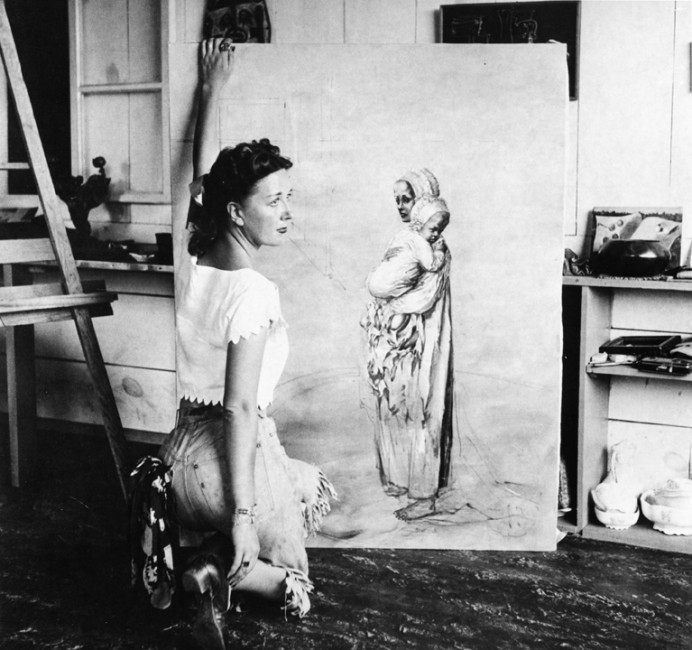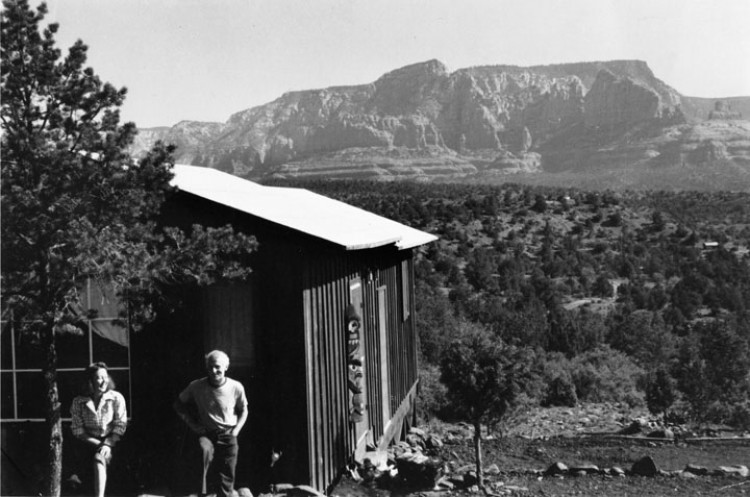Time in Sedona
After meeting, Dorothea and Max soon fell in love and became inseparable, they traveled together, lived together, and worked together. Eventually, this led them to Arizona in 1943, where they lived periodically for the next thirteen years, often spending their summers in a tiny home. From 1944-1945 they spent time in Long Island before getting married in a joint ceremony with Man Ray and Juliet Browner in October 1945, returning to Sedona in 1946. The year is filled with guests, notable names like Marcel Duchamp, George Balanchine, his wife Tanaquil Leclercq, Roland Penrose, Lee Miller, and Caresse Crosby. Dorothea describes this time in Sedona in Birthday and Between Lives, focusing on Capricorn Hill the name that Max gives to their humble home, Capricorn is also the name of a sculpture he creates that portrays a very abstract representation of a woman and a man. While in Sedona they explored different forms of Native art and even named their small dog Kachina after the Puebloan ceremonial rooms found in many ruins around Northern Arizona. Dorothea and Max believed that Sedona and its surrounding wilderness were fuel to their creative fires, allowing the desert to inspire their art. 1947 was accompanied by more visitors with Cartier-Bresson, John Malcolm Brinnin, Kay Sage, Yves Tanguy, Vittorio Rieti, and more coming to spend time in the hidden treasure. The year 1947 brought more than just visitors it was also the year where Dorothea and Max decided to put down some small roots in Sedona and built their own home in Sedona described in the two passages below.
"In Arizona, there was nothing about our made-it-myself–two-room house that visibly merited a name. Capricorn Hill. Alone it stood, if not crooked at any rate somewhat rakish, stuck on a landscape of such stunning red and gold grand or that its life could be only a matter of brevity, a beetle of brown boards and tarpaper roof waiting for a metamorphosis. Up on its hill, bifurcating the winds and rather friendly with the stars that swayed over our outdoor table, like chandeliers. On those evenings when there were visitors we might have been Magnasco pirates reveling on a sea-sprayed deck, sails furled, candle lamps steady, while the world spun backward and our voice hung upside-down in the desert night air. Tales were tall, arguments were musical, philosophy gave pause. "
Tanning, Dorothea. Birthday. Santa Monica [Calif.]: Lapis Press, 1986. pg. 85
"In Arizona, there was nothing about our made-it-myself–two-room house that visibly merited a name. Capricorn Hill. Alone it stood, if not crooked at any rate somewhat rakish, stuck on a landscape of such stunning red and gold grand or that its life could be only a matter of brevity, a beetle of brown boards and tarpaper roof waiting for a metamorphosis. Up on its hill, bifurcating the winds and rather friendly with the stars that swayed over our outdoor table, like chandeliers. On those evenings when there were visitors we might have been Magnasco pirates reveling on a sea-sprayed deck, sails furled, candle lamps steady, while the world spun backward and our voice hung upside-down in the desert night air. Tales were tall, arguments were musical, philosophy gave pause. "
Tanning, Dorothea. Birthday. Santa Monica [Calif.]: Lapis Press, 1986. pg. 85
In 1948, Dorothea and Max travel to New York for Dorothea's second exhibition and then spend the next two years in France, where they work on different projects and even spend an afternoon with Picasso. They return to Sedona, in 1950, before flitting off to Hollywood, Hawaii, and Paris once again. By 1954 Dorothea and Max are splitting their time between Italy and France before returning one last time to Sedona in 1956 and being forced to say goodbye to Sedona just a year later when all efforts to get Max American citizenship fails. It's at this point when they decide to move to France for good, where Max ends up spending his final years, Dorothea describes this leaving in her book Birthday.
"You would think that here ends the story. You would think that those velvet nights, preludes to each passionate day in a landscape so charged that ‘if Wagner had seen this his music would be so much louder than it is already’ we said you; would think, then, that paradise would hold us in its thrall, sustain us hilariously in our ongoing combat with need, the creature kind; would provide the sweep of background—along luminous brushstroke upon which to pin, plaster, paste and paint our questions and our answers for the rest of our lives. Studded with discoveries in nearby Indian caves, canyons, pueblos, aged and wise. Cowboy Elmer, exuberantly in League with the primordial, guides us through the Colorado River Rapids (replaced now by concrete dams) in rubber boots. He pitches tents, makes cowboy biscuits and shows us Indian hieroglyphs, in fastness where the invader (we) had never walked... Arriving at Lee’s Ferry two days late — we had played at movie-making in a hidden canyon — we were hailed with relief by the locals, even newsmen, and our movie footage was nicely integrated back in New York in Hans Richers avant-grade film, 8 by 8. It all showed, alas, that paradise was indeed somewhere not quite habitable, or even believable, or — can it be? — desirable. Were Adam and Eve really chased from the garden? Or did they leave?
Hung about with valid reasons, if such were required, we locked our flimsy door and left for France."
Tanning, Dorothea. Birthday. Santa Monica [Calif.]: Lapis Press, 1986. pg. 86-87


